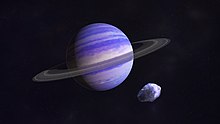Neptunian exoplanet
Appearance

Neptunian exoplanets are similar in size to the ice giants Neptune and Uranus in the Solar System. Neptunian exoplanets may have a mixture of interiors though all would be rocky with heavier metals at their cores. Neptunian planets typically have hydrogen- and helium-dominated atmospheres.[1]
There are several recognized subtypes of Neptunian exoplanets:
- Hot Neptune – orbiting close to its star
- Helium planet – a hypothetical type that can form from hot Neptune via hydrogen evaporation, leaving a helium-dominated atmosphere
- Mini-Neptune – considerably smaller than Neptune but still having a thick hydrogen-helium envelope, relatively common
- Super-puff – inflated planets with unusually low mean density
- Hycean planet – a hypothetical transitional type to ocean planets with a thin, hydrogen-helium-dominated atmosphere overlaying a liquid water ocean
List of Neptunian exoplanets
[edit]HAT
[edit]- A Neptune like planet was found in the planetary system around the HAT-P-26b star system.[2]
- HAT-P-11b[2]
GJ
[edit]TOI
[edit]OGLE
[edit]References
[edit]- ^ "Neptune-like | Planet Types". Exoplanet Exploration: Planets Beyond our Solar System. Retrieved 2021-12-08.
- ^ a b c d e "Eyes On Exoplanets – Exoplanet Exploration: Planets Beyond our Solar System". exoplanets.nasa.gov. Retrieved 2021-12-08.
